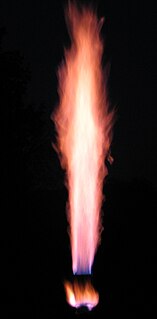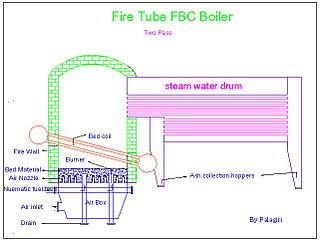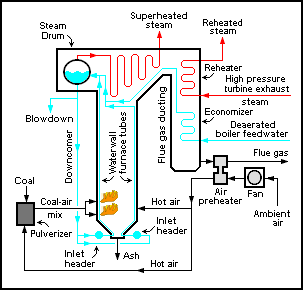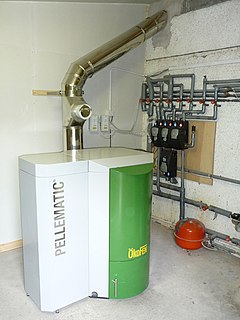
Wood gas is a syngas fuel which can be used as a fuel for furnaces, stoves and vehicles in place of gasoline, diesel or other fuels. During the production process biomass or other carbon-containing materials are gasified within the oxygen-limited environment of a wood gas generator to produce hydrogen and carbon monoxide. These gases can then be burnt as a fuel within an oxygen rich environment to produce carbon dioxide, water and heat. In some gasifiers this process is preceded by pyrolysis, where the biomass or coal is first converted to char, releasing methane and tar rich in polycyclic aromatic hydrocarbons.

A boiler is a closed vessel in which fluid is heated. The fluid does not necessarily boil. The heated or vaporized fluid exits the boiler for use in various processes or heating applications, including water heating, central heating, boiler-based power generation, cooking, and sanitation.

A furnace, referred to as a heater or boiler in British English, is an appliance used to generate heat for all or part of a building. Furnaces are mostly used as a major component of a central heating system. Furnaces are permanently installed to provide heat to an interior space through intermediary fluid movement, which may be air, steam, or hot water. Heating appliances that use steam or hot water as the fluid are normally referred to as a residential steam boilers or residential hot water boilers. The most common fuel source for modern furnaces in North America and much of Europe is natural gas; other common fuel sources include LPG, fuel oil, wood and in rare cases coal. In some areas electrical resistance heating is used, especially where the cost of electricity is low or the primary purpose is for air conditioning. Modern high-efficiency furnaces can be up to 98% efficient and operate without a chimney, with a typical gas furnace being about 80% efficient. Waste gas and heat are mechanically ventilated through either metal flue pipes or polyvinyl chloride (PVC) pipes that can be vented through the side or roof of the structure. Fuel efficiency in a gas furnace is measured in AFUE.

Fluidized bed combustion (FBC) is a combustion technology used to burn solid fuels.
A combustor is a component or area of a gas turbine, ramjet, or scramjet engine where combustion takes place. It is also known as a burner, combustion chamber or flame holder. In a gas turbine engine, the combustor or combustion chamber is fed high-pressure air by the compression system. The combustor then heats this air at constant pressure. After heating, air passes from the combustor through the nozzle guide vanes to the turbine. In the case of a ramjet or scramjet engines, the air is directly fed to the nozzle.

A fossil fuel power station is a thermal power station which burns a fossil fuel, such as coal or natural gas, to produce electricity. Fossil fuel power stations have machinery to convert the heat energy of combustion into mechanical energy, which then operates an electrical generator. The prime mover may be a steam turbine, a gas turbine or, in small plants, a reciprocating gas engine. All plants use the energy extracted from expanding gas, either steam or combustion gases. Although different energy conversion methods exist, all thermal power station conversion methods have efficiency limited by the Carnot efficiency and therefore produce waste heat.
A cyclone furnace is a type of coal combustor commonly used in large industrial boilers.

A thermal power station is a power station in which heat energy is converted to electricity. Typically, fuel is used to boil water in a large pressure vessel to produce high-pressure steam, which drives a steam turbine connected to an electrical generator. The low-pressure exhaust from the turbine passes through a steam condenser and is recycled to where it was heated. This is known as a Rankine cycle. Natural gas can also be burnt directly in a gas turbine similarly connected to a generator.

An air preheater is any device designed to heat air before another process (for example, combustion in a boiler With the primary objective of increasing the thermal efficiency of the process. They may be used alone or to replace a recuperative heat system or to replace a steam coil.
A pulverized coal-fired boiler is an industrial or utility boiler that generates thermal energy by burning pulverized coal that is blown into the firebox.
Co-firing is the combustion of two different types of materials at the same time. One of the advantages of co-firing is that an existing plant can be used to burn a new fuel, which may be cheaper or more environmentally friendly. For example, biomass is sometimes co-fired in existing coal plants instead of new biomass plants. Another example is that biomass primary fuel fractions can be cofired with waste-derived fuels in biomass plants leading to an environmentally friendly destruction of waste fractions and cost-effective heat and power production. Co-firing can also be used to improve the combustion of fuels with low energy content. For example, landfill gas contains a large amount of carbon dioxide, which is non-combustible. If the landfill gas is burned without removing the carbon dioxide, the equipment may not perform properly or emissions of pollutants may increase. Co-firing it with natural gas increases the heat content of the fuel and improves combustion and equipment performance. As long as the electricity or heat produced with the biomass and landfill gas was otherwise going to be produced with non-renewable fuels, the benefits are essentially equivalent whether they are cofired or combusted alone. Also, co-firing can be used to lower the emission of some pollutants. For example, co-firing biomass with coal results in less sulfur emissions than burning coal by itself.
A pulverizer or grinder is a mechanical device for the grinding of many different types of materials. For example, a pulverizer puritch is used to pulverize coal for combustion in the steam-generating furnaces of coal power plants.
A flue-gas stack, also known as a smoke stack, chimney stack or simply as a stack, is a type of chimney, a vertical pipe, channel or similar structure through which combustion product gases called flue gases are exhausted to the outside air. Flue gases are produced when coal, oil, natural gas, wood or any other fuel is combusted in an industrial furnace, a power plant's steam-generating boiler, or other large combustion device. Flue gas is usually composed of carbon dioxide (CO2) and water vapor as well as nitrogen and excess oxygen remaining from the intake combustion air. It also contains a small percentage of pollutants such as particulate matter, carbon monoxide, nitrogen oxides and sulfur oxides. The flue gas stacks are often quite tall, up to 400 metres (1300 feet) or more, so as to disperse the exhaust pollutants over a greater area and thereby reduce the concentration of the pollutants to the levels required by governmental environmental policy and environmental regulation.
Tangential firing is a method of firing a fuel to heat air in thermal power stations. The flame envelope rotates ensuring thorough mixing within the furnace, providing complete combustion and uniform heat distribution.

A coal-fired power station or coal power plant is a thermal power station which burns coal to generate electricity. Worldwide there are about 8,500 coal-fired power stations totaling over 2,000 gigawatts capacity. They generate about a third of the world's electricity, but cause many illnesses and early deaths, mainly from air pollution.

A wood-burning stove is a heating or cooking appliance capable of burning wood fuel and wood-derived biomass fuel, such as sawdust bricks. Generally the appliance consists of a solid metal closed firebox, often lined by fire brick, and one or more air controls. The first wood-burning stove was patented in Strasbourg in 1557, two centuries before the Industrial Revolution, which would make iron an inexpensive and common material, so such stoves were high end consumer items and only gradually spread in use.

A coal burner is a mechanical device that burns pulverized coal into a flame in a controlled manner. Coal burner is mainly composed of pulverized coal machine, host of combustion machine control system, ignition system, the crater and others.
Pellet heating is a heating system in which wood pellets are combusted. Other pelletized fuels such as straw pellets are used occasionally. Today's central heating system which run on wood pellets as a renewable energy source are comparable in operation and maintenance of oil and gas heating systems.

A pellet boiler is a heating system that burns wood pellets. Pellet boilers are used in central heating systems for heat requirements from 3.9 kW (kilowatt) to 1 MW (megawatt) or more. Pellet central heating systems are used in single family homes, and in larger residential, commercial, or institutional applications. Pellet boiler systems run most efficiently at full load and can usually be regulated down to 30% of full load. Since the warm up phase of pellet boilers usually takes longer than for oil or gas firing systems, short burning phases have negative effects on the fuel efficiency. In order to improve energy efficiency and reduce harmful emissions, pellet boilers are usually combined with buffer systems, such as insulated water tanks.
Computational fluid dynamics (CFD) are used to understand complex thermal flow regimes in power plants. The thermal power plant may be divided into different subsectors and the CFD analysis applied to critical equipment/components - mainly different types of heat exchangers - which are of crucial significance for efficient and trouble free long-term operation of the plant.










